
|
 |
MEDIA RELATIONS OFFICE
JET PROPULSION LABORATORY
CALIFORNIA INSTITUTE OF TECHNOLOGY
NATIONAL AERONAUTICS AND SPACE ADMINISTRATION
PASADENA, CALIF. 91109. TELEPHONE (818) 354-5011
http://www.jpl.nasa.gov
Contact: Mary Beth Murrill
FOR IMMEDIATE RELEASE November 12, 1998
STARDUST ARRIVES AT KENNEDY SPACE CENTER FOR LAUNCH PREPARATIONS
NASA's Stardust spacecraft, designed to fly to a comet,
collect a sample and return it to Earth, has arrived at the
Kennedy Space Center, FL, to begin pre-launch processing.
Time Lapse Movie
STARDUST Spacecraft At
Kennedy Space Center
November 12, 1998
|
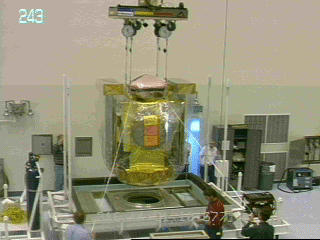
STARDUST Spacecraft
MPEG Movie - 1.5 MB
|
Need help in running animations?
Look here for
information on how to setup
your browser for animations.
|
Launch aboard a Delta 7426 rocket is currently targeted for
February 6, 1999 from Cape Canaveral Air Station.
Stardust will be the first spacecraft ever to bring cometary
material back to Earth for analysis by scientists worldwide.
Comets are believed to contain the original building blocks of
the planets and perhaps those of life itself. Early in Earth's
history, comets laden with water ice slammed into the planet,
maybe providing the source of our oceans. When Stardust returns
its pristine comet samples, scientists will be able to examine
for the first time the key ingredients of the original recipe
that created the planets.
The spacecraft was shipped from Lockheed Martin
Astronautics, Denver, CO, aboard a C-17 aircraft and landed at
Kennedy Space Center this morning. Stardust is being built
by Lockheed Martin Astronautics and is managed by NASA's Jet
Propulsion Laboratory, Pasadena, CA. The principal investigator
of the mission is space particle scientist Dr. Donald Brownlee of
the University of Washington. Dr. Kenneth Atkins of JPL is the
project manager.
|
No copyright protection is asserted for this photography.
If a recognizable person appears in this photograph, use for commercial
purposes may infringe a right of privacy or publicity.
It may not be used to state or imply the endorsement by NASA employees of a
commercial product, process or service, or used in any other manner that
might mislead. Accordingly, it is requested that if this photograph is used
in advertising and other commercial promotion, layout and copy be submitted
to NASA prior to release.
PHOTO CREDIT: NASA or National Aeronautics and Space Administration
Clicking on any of the thumbnail images below will bring up a higher
resolution version of that image.
KENNEDY SPACE CENTER, FLA. -- After arrival at the Shuttle Landing Facility
on a Boeing C-17 in the early morning hours, the crated Stardust spacecraft
is unloaded from the aircraft. Built by Lockheed Martin
Astronautics near Denver, Colo., for the Jet Propulsion Laboratory (JPL) and
NASA, the spacecraft Stardust will use a unique medium called aerogel to
capture comet particles and interstellar dust for later analysis. Stardust
will be launched aboard a Boeing Delta 7426 rocket targeted for Feb. 6,
1999. The collected samples will return to Earth in a re-entry capsule to be
jettisoned from Stardust as it swings by Earth in January 2006.
|
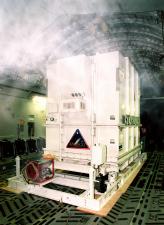
Photo Number: KSC-98PC-1621
High Resolution JPEG - 1.9 MB
|
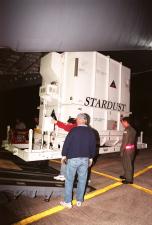
Photo Number: KSC-98PC-1622
High Resolution JPEG - 1.4 MB
|
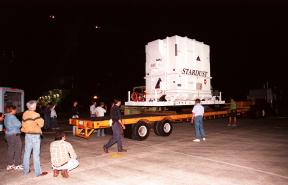
Photo Number: KSC-98PC-1623
High Resolution JPEG - 973K
|
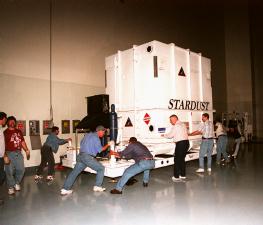
Photo Number: KSC-98PC-1624
High Resolution JPEG - 987K
|
More Photos Below
|
Stardust's main objective is to collect and bring to Earth
particles flying off the nucleus of Comet Wild-2 in January 2004.
It will also bring back samples of interstellar dust including
the recently discovered dust streaming into the solar system from
other stars. The spacecraft will send back pictures of Wild-2,
count the comet particles striking the spacecraft, and produce
real-time analyses of the composition of the material coming off
the comet.
A unique substance called aerogel is the medium that will be
used to catch and preserve comet samples. When Stardust swings
by Earth in January 2006, the samples encased in a reentry
capsule will be jettisoned and parachute to a pre-selected site
in the Utah desert.
The length of the Stardust main bus is 1.7 meters (5.5
feet), about the size of an average office desk. The spacecraft
weighs 385 kilograms (849 pounds). Among the processing
activities to be performed are installation and testing of the
solar arrays, final installation and testing of some spacecraft
instruments followed by an overall spacecraft functional test.
The spacecraft can then be fueled and mated to the Star 37 solid
propellant upper-stage booster.
Meanwhile, at Launch Complex 17, the Delta II rocket will be
undergoing erection and pre-launch checkout by Boeing. The first
stage is scheduled to be installed into the launcher on January
5, 1999. Four solid-rocket boosters will be attached around the
base of the first stage the next day. The second stage will be
mated atop the first stage on January 8, and the spacecraft
fairing will be hoisted into the clean room of the pad's mobile
service tower January 11.
Stardust will be transported to Complex 17 on January 28 for
hoisting aboard the Delta rocket on Pad A and mating to the
second stage. After the spacecraft undergoes state of health
checks, the fairing can be placed around it three days later.
Launch is currently targeted for February 6 at 4:08 p.m. EST.
The 20-day launch opportunity ends February 25.
Stardust is the fourth under NASA's Discovery Program of
low-cost science missions, following Lunar Prospector, Mars
Pathfinder and the Near Earth Asteroid Rendezvous (NEAR). The
goal of NASA's Discovery Program is to launch many smaller
missions with shorter development time that perform focused
science at lower cost.
JPL is a division of the California Institute of Technology,
Pasadena, CA.
|
No copyright protection is asserted for this photography.
If a recognizable person appears in this photograph, use for commercial
purposes may infringe a right of privacy or publicity.
It may not be used to state or imply the endorsement by NASA employees of a
commercial product, process or service, or used in any other manner that
might mislead. Accordingly, it is requested that if this photograph is used
in advertising and other commercial promotion, layout and copy be submitted
to NASA prior to release.
PHOTO CREDIT: NASA or National Aeronautics and Space Administration
Clicking on any of the thumbnail images below will bring up a higher
resolution version of that image.
|
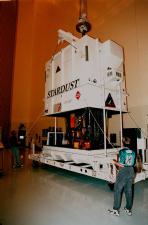
Photo Number: KSC-98PC-1630
In the Payload Hazardous Service Facility,
workers lift the cover that protected the Stardust spacecraft during its
journey to KSC.
High Resolution JPEG - 1.3 MB
|
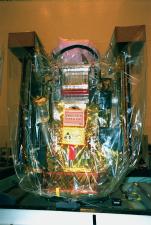
Photo Number: KSC-98PC-1631
The Stardust spacecraft sits wrapped in plastic covering.
High Resolution JPEG - 1.5 MB
|
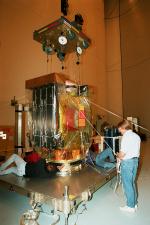
Photo Number: KSC-98PC-1632
A
worker secures the Stardust spacecraft to a workstand.
High Resolution JPEG - 1.3 MB
|
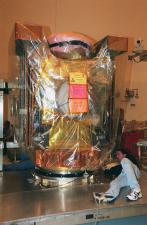
Photo Number: KSC-98PC-1633
Workers lower the Stardust spacecraft onto a workstand.
High Resolution JPEG - 1.3 MB
|

Photo Number: KSC-98PC-1634
Workers move the Stardust spacecraft on its workstand from the air lock to
the high bay.
High Resolution JPEG - 1.6 MB
|
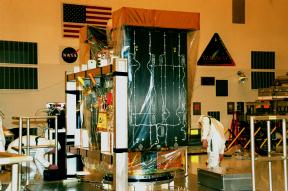
Photo Number: KSC-98PC-1635
Workers check the placement of the Stardust spacecraft's workstand in the
high bay.
High Resolution JPEG - 1.7 MB
|
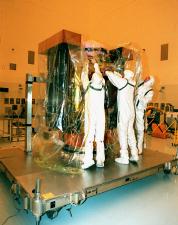
Photo Number: KSC-98PC-1636
Workers begin removing the protective plastic covering of the Stardust
spacecraft.
High Resolution JPEG - 2.1 MB
|
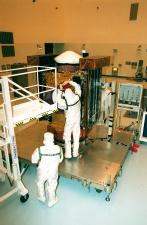
Photo Number: KSC-98PC-1637
Workers begin checking the Stardust spacecraft after removing its protective
cover.
High Resolution JPEG - 1.5 MB
|
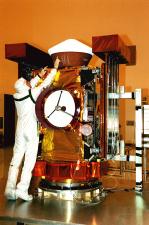
Photo Number: KSC-98PC-1638
A worker looks over the re-entry capsule on top of the Stardust spacecraft.
High Resolution JPEG - 1.6 MB
|
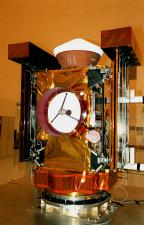
Photo Number: KSC-98PC-1639
The Stardust spacecraft sits in the Payload
Hazardous Service Facility waiting to undergo installation and testing of
the solar arrays, plus final installation and testing of spacecraft
instruments followed by an overall spacecraft functional test. At the top is
the re-entry capsule.
High Resolution JPEG - 1.4 MB
|
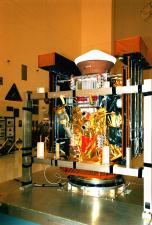
Photo Number: KSC-98PC-1640
The Stardust spacecraft sits in the Payload
Hazardous Service Facility.
High Resolution JPEG - 1.7 MB
|
NOTE TO EDITORS: Images to accompany this release are
available on the web at:
http://www.ast.lmco.com/frameset.shtml?top=Media_Gallery,content=gallery_stardust
Last Updated: November 26, 2003
|
